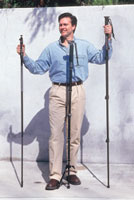Gitzopods And Friends
There Is More To Monopods Than Meets The Eye
What meets the casual eye regarding
monopods is one tripod leg with a 1/4 "-20 screw at the top. However,
those who are familiar with the monopod's unique benefits, and are properly
versed in its technique, know that its beauty is more than skin deep.
|
|||
If you load your camera with ISO 100
film because the weather looks sunny, only to find yourself under leaden
gray skies an hour later, a monopod will allow steady exposures at considerably
lower shutter speeds. |
|||
OK, so monopods really do serve a useful
purpose after all. But why choose any particular one over another a
1/4 "-20 screw-on-a-stick is a 1/4 "-20 screw-on-a-stick, right? Not by
a long shot. |
|||
Since the totally unique Gitzopod is unquestionably the most unusual and adaptable monopod available, it earns top honors in the individuality department. Its mechanical specs are: 597/8 " maximum height; 265/8 " minimum height (in-use vertical configuration; folds to 141/4 " for storage); weight is 21/2 lbs; five sections; load rating is 11 lbs. It is the most compact of all monopods, easily stored in carryon bags and even many camera bags. Quite a contortionist, the Gitzopod can be extended, collapsed, folded, bent, tilted, and twisted into a conventional monopod, shoulder-pod, chest-pod, bi-pod, wall-pod, and table or knee-pod, as demonstrated in the accompanying illustrations. Its camera platform has a limited tilting range that's adequate for most situations. For more extreme tilts, or to flip a camera 90˚ for vertical compositions, a small head can be added. The length of the built-in shoulder brace is adjustable, and the shoulder yoke can be turned 90˚ to brace against your chest; this works better than the shoulder position for cameras with centrally located viewfinder eyepieces. The bottom leg section has two scribed markings that are convenient for duplicating the exact height each and every time. It benefited from Gitzo's recent restyling of their whole line of tripods, with larger, convex leg locking collars that are much easier to grip than previously, as well as a handsome finish. A substantial neck harness is supplied, allowing hands-free operations such as film changing. The only improvement I would like to see on this tremendously versatile monopod is a more positive, "snap-in " locking arrangement on the folding center joint. The tightening lever is adequate as long as you remember to orient the hinge forward; if oriented to the back, the joint can "bird-knee " a bit if you lean forward with the upper section. In any circumstance where traveling with a tripod is just too cumbersome, the Gitzopod will give you more alternative camera support options than any other device on the market. It's a bit pricey, so shop around, but it's money well spent. |
|||
The Gitzo MonoTrek is much lighter duty
than the Gitzopod. It is specifically designed for use as a walking stick
(the joints of most monopods aren't designed to take the constant vertical
pounding), a feature that will be appreciated by dayhikers. A comfortable
grip and swiveling wrist strap add to its appeal. Best suited to point-and-shoots
and other lighter weight cameras, the G1560 model comes with a small ball
head, which allows easy vertical orientation of the camera. The head is
removable and could be replaced with any heavier-duty unit adaptable to
a 3/8 " screw; a snap-on cover is supplied for the standard head. Minimum
length (with snap-on cover) is 311/2 "; maximum camera platform height
is 64 "; it has three sections, weighs 1 lb, and has a load rating of 41/4
lbs. It also comes with an accessory "all-weather shoe, " which provides
a footing in snow and soft sand. |
- Log in or register to post comments






































